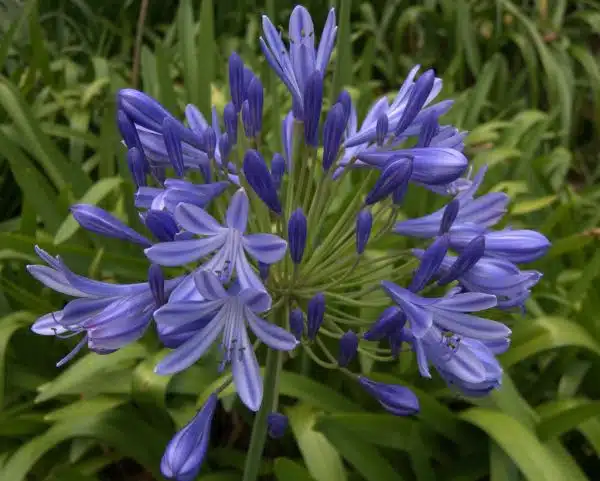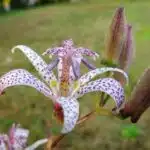Agapanthus africanus, commonly known as African lilies, are a beautiful and exotic plant that can be grown indoors with proper care. These plants feature long green leaves and tall stems adorned with clusters of blue or white flowers that bloom in the summer months. While these plants can be found growing wild in their native Africa, they have become increasingly popular as houseplants in many parts of the world.
For those looking to add a touch of elegance to their indoor garden, growing African lilies is an excellent option. However, it is important to understand the specific needs and requirements of these plants in order to successfully grow them indoors. This article will provide a comprehensive guide on how to properly care for and cultivate African lilies inside your home, from choosing the right soil and lighting conditions to fertilizing and watering techniques. With the right knowledge and attention, you can enjoy the beauty and splendor of these unique plants all year round.
Introduction To African Lilies
African lilies, scientifically known as Agapanthus africanus, are a species of flowering plants native to South Africa. These beautiful plants are highly adaptable and can be cultivated indoors with ease. Growing these lilies indoors offers several benefits, including enhancing the aesthetic appeal of your home or office space.
To grow African lilies indoors, it is important to understand their growing conditions. These plants require well-draining soil with a pH range between 6.0 and 7.5. They also need plenty of light, so it’s best to place them near south-facing windows where they can receive direct sunlight for at least six hours per day. In addition, maintaining adequate humidity levels will promote healthy growth and prevent pests from infesting the plant.
Having African lilies indoors provides numerous benefits beyond aesthetics. These plants help purify the air by removing toxins such as formaldehyde and benzene, creating a healthier living environment for you and your loved ones. Additionally, they have been shown to reduce stress levels and improve mental health by promoting relaxation and concentration. Understanding agapanthus africanus will enable you to cultivate these remarkable plants successfully in your indoor space while enjoying all their benefits.
Understanding Agapanthus Africanus
African Lilies, or Agapanthus Africanus, are a popular plant for their stunning blue or white flowers and hardy nature. Understanding the growth patterns of this plant is crucial in order to provide it with the best care possible. When growing African Lilies indoors, it’s important to note that they require bright light but not direct sunlight. To ensure proper growth patterns, place them in a south-facing window or under a grow light.
When it comes to choosing the best containers for indoor African Lilies, make sure they have drainage holes in the bottom to prevent waterlogging. Terracotta pots are excellent choices as they allow for airflow and help regulate moisture levels in the soil. It’s also important to choose a container that’s slightly larger than the current root ball of your plant.
Indoor care for African Lilies involves maintaining a consistent temperature between 60-75°F (15-24°C) and humidity levels between 40-60%. Avoid placing them near air conditioning units or heaters as they prefer a stable environment. By understanding these growth patterns and providing your Agapanthus Africanus with the right conditions indoors, you can enjoy their beautiful blooms year-round. In the next section, we’ll discuss how choosing the right soil is essential for optimal growth and health of your African Lilies.
Choosing The Right Soil For Your African Lilies
When it comes to growing African lilies indoors, choosing the right soil is crucial for the plant’s success. The ideal soil for African lilies should be well-draining and rich in organic matter. A good quality potting mix that contains perlite or vermiculite can aid in drainage and provide nutrients to your plants.
Choosing the Right Container is also essential when growing African lilies inside. The container should have drainage holes at the bottom, which will allow excess water to drain out. It is also advisable to choose a container that is slightly larger than the plant’s root ball, as this will give ample space for the roots to grow.
The Importance of Drainage cannot be stressed enough when growing African lilies indoors. Poorly drained soil can lead to root rot, which can kill your plant quickly. To ensure adequate drainage, you may add some gravel or stones at the bottom of the container before adding soil. This way, water won’t accumulate at the bottom of the pot and cause problems for your African lily plant.
As we’ve seen, selecting the right soil and container with proper drainage are critical factors in successfully growing African lilies indoors. Next, we’ll explore another crucial aspect of indoor cultivation: lighting requirements for these vibrant flowers.
Lighting Requirements For Indoor African Lilies
After choosing the right soil for your African lilies, it is now time to consider the lighting requirements. African lilies thrive in full sun, but they can also grow well indoors with the right lighting conditions. One important thing to remember is that artificial lighting cannot replace natural sunlight entirely.
When growing African lilies indoors, you need to provide them with at least six hours of direct sunlight or bright indirect light daily. If you have a south-facing window that provides enough sunlight, place your plant there. However, if you do not have access to natural light or your window does not get enough sunlight, you can supplement it with artificial lighting.
Using artificial lighting for indoor plants has become increasingly popular nowadays. You can use LED grow lights as an alternative to natural sunlight. These lights are energy-efficient and have a longer lifespan than traditional bulbs. When growing African lilies indoors using LED grow lights, make sure to adjust the distance between the plant and the light source according to their specific needs.
Moving on from the lighting requirements for indoor African lilies, we will now focus on watering techniques. Proper watering is crucial in maintaining healthy African lilies as they require regular watering during their growth period. Overwatering or underwatering can lead to root rot or dehydration, respectively. It is important to keep the soil moist but not waterlogged.
To water your African lily plant properly, you need to check if the top inch of soil is dry before watering again. You can insert a finger into the soil up to two inches deep and feel if it’s still moist or already dry. Water your plant slowly and deeply until water comes out of its drainage holes, then let it drain completely before putting it back in its container.
In conclusion, proper lighting conditions are essential when growing African lilies indoors as they require at least six hours of direct or bright indirect light daily. Artificial lighting options such as LED grow lights are also available to supplement natural sunlight. Additionally, watering techniques should be done properly to keep the soil moist but not waterlogged, ensuring healthy growth and development of your African lily plant.
Watering Techniques For African Lilies
Watering African Lilies can be a bit tricky. Overwatering is one of the most common mistakes one can make while watering these plants. It is essential to understand that African Lilies prefer well-drained soil and do not tolerate water-logged soil. Overwatering can lead to root rot, which can ultimately kill your plant. Therefore, it is crucial to prevent over-watering by letting the topsoil dry out before watering again.
On the other hand, under watering can also be harmful to your African Lilies. These plants require regular moisture to thrive, and if they do not receive adequate water, they will show signs of dehydration. The leaves will start turning yellow and wilted, and the flowers may not bloom correctly. To prevent under-watering, make sure you water your African Lilies regularly but avoid making the soil too soggy.
To ensure your African Lilies grow healthy and beautiful indoors, it’s essential to provide them with proper care and maintenance. Watering them accurately is a crucial part of their care routine, as it affects their growth significantly. Observe your plants carefully for any signs of over or under-watering and adjust accordingly. In the next section, we will discuss fertilizing techniques for your African Lilies to promote their growth and development further.
Fertilizing Your African Lilies
When selecting fertilizer for African Lilies, it is important to consider the macro- and micro-nutrient content as well as the nutrient release rate. Proper application of fertilizer is essential to ensure the plant is getting the right amount of nutrients. Over-fertilization can detrimentally impact the health of the plant, so it is important to follow the label directions. As African Lilies are planted in containers, the fertilizer should be applied on a monthly basis or as needed.
Choosing The Right Fertilizer
Choosing the right fertilizer for your African lilies is an essential factor in ensuring their healthy growth and development. As a horticulturalist, I recommend using organic fertilizers as they promote soil health by increasing microbial activity and nutrient absorption. Organic fertilizers are derived from natural sources and release nutrients slowly over time, providing a steady supply to your plants.
On the other hand, synthetic fertilizers provide a quick boost of nutrients but can have adverse effects on plant growth if overused. They contain high levels of salts that can damage the roots and reduce water uptake, leading to stunted growth and even death. It is crucial to follow the manufacturer’s instructions when using synthetic fertilizers to avoid these negative consequences.
To maximize the benefits of organic fertilizers, use them in combination with compost or well-rotted manure. This will improve soil structure and increase water-holding capacity, allowing your African lilies to access nutrients more efficiently. With proper care and attention, your African lilies will thrive indoors and bring joy with their stunning blooms year after year.
Applying Fertilizer Properly
Applying fertilizer properly is crucial in maintaining the health and vitality of your African lilies. Knowing the right time to apply fertilizers and how much to use can make a significant difference in their growth and development. As a horticulturalist, I recommend using the best fertilizer brands that contain a balanced mix of nutrients necessary for optimal plant growth.
When applying fertilizers, it’s essential to follow the instructions on the packaging carefully. Overfertilizing can damage your plants by increasing salt levels in the soil, which can lead to root burn or death. Organic fertilizers release nutrients slowly over time, so it’s best to apply them during the growing season when your African lilies are actively growing.
Another critical factor in applying fertilizer is ensuring that it’s distributed evenly around your plants’ root zone. This can be achieved by broadcasting granular fertilizers or diluting liquid ones before application. It’s also essential to avoid getting fertilizers on leaves or stems as this can cause burning or other damage. By following these tips, you’ll ensure that your African lilies receive just the right amount of nutrients they need for healthy growth and blooming.
In conclusion, applying fertilizer properly is key in achieving optimal results when growing African lilies. Whether you choose organic or chemical fertilizers, it’s important to follow instructions carefully and distribute them evenly around your plants’ root zones. With proper care and attention, your African lilies will reward you with stunning blooms year after year.
Repotting Your African Lilies
Ah, the joys of repotting! It’s like giving your African lilies a new lease on life. If you’re seeing roots poking out of the drainage holes or if the soil is compacted and dry, it’s time to repot. This exercise will not only prevent root-bound plants but also improve their overall health and growth.
Repotting techniques vary depending on the size of your plant and its container. Small potted plants can be gently removed from their containers by holding the base of the plant while tapping the pot upside down. Larger plants may require a little more muscle, so enlist the help of a friend if needed. Once removed from its pot, loosen any excess soil around the roots before replanting into a slightly larger container with fresh soil.
When it comes to container options, choose one that has good drainage and is large enough for your plant to grow into. Terracotta pots are popular among gardeners as they allow for better air circulation and moisture retention. However, plastic or ceramic pots are also suitable as long as they have drainage holes at the bottom.
With your African lilies now happily settled into their new homes, it’s time to address common pests and diseases that could potentially harm them. But before we dive into that topic, let’s first discuss how to care for these beauties and keep them healthy in their indoor environment.
Dealing With Common Pests And Diseases
- African lilies, or Agapanthus africanus, can be susceptible to various pests and diseases if grown indoors, so it is important to identify the symptoms of the most common issues.
- Pest control may involve the use of insecticides or other chemical treatments, or alternatively, mechanical methods such as pruning, hand-picking and trapping.
- For diseases such as fungal and bacterial infections, fungicides may be necessary to control the spread and severity of the issue.
- Prevention of pests and diseases can be achieved by providing the lilies with proper irrigation and drainage, as well as adequate light, temperature and humidity levels.
- Regular monitoring of the plants is also important for early detection, allowing for the implementation of corrective measures before the problem becomes too severe.
- In addition, proper sanitation of the growing environment and using healthy, disease-free plants can help reduce the risks of pests and diseases in African lilies.
Identifying Pests And Diseases
Identifying pests and diseases is an essential aspect of growing African lilies indoors. These plants are susceptible to a range of ailments, including fungal infections, spider mites, and mealybugs. Early detection and prompt treatment can prevent infestations from becoming severe, resulting in stunted growth or even death of the plant.
Preventing infestations is the best way to avoid dealing with pests and diseases in African lilies. Ensure that the soil is well-drained and not waterlogged, as this can lead to root rot. Keep the plant in an area with good air circulation and adequate sunlight. Regularly inspect the plant for any signs of pests or disease, such as yellowing leaves or discolored spots.
If you do notice any pests or diseases on your African lilies, there are natural remedies that you can use to treat them. For example, neem oil is effective against spider mites and other insects, while a mixture of baking soda and water can help control fungal infections. However, it’s important to use these remedies correctly and not overdo it, as they can also harm beneficial insects like bees or ladybugs that may be present in your indoor garden. By staying vigilant and using natural remedies when necessary, you can keep your African lilies healthy and thriving all year round.
Controlling Pests And Diseases
Integrated pest management (IPM) is a holistic approach to controlling pests and diseases that involves using a combination of methods to minimize the use of harmful chemicals. IPM is particularly useful in indoor gardening, where chemical pesticides can be hazardous to human health and the environment. By focusing on prevention, early detection, and natural remedies, gardeners can keep their African lilies healthy and thriving without resorting to toxic chemicals.
One key aspect of IPM is identifying the specific pests and diseases affecting your African lilies. This allows you to choose the most appropriate natural remedy for each problem. For example, neem oil is effective against spider mites, while a mixture of baking soda and water can help control fungal infections. Regularly inspecting your plants for signs of damage or infestation is crucial for catching problems early before they become severe.
Another important element of IPM is creating a healthy growing environment for your African lilies. This includes providing adequate sunlight, good air circulation, and well-drained soil. A healthy plant is less likely to succumb to pests or diseases than a stressed or weakened one. Using natural fertilizers like compost or worm castings can also promote plant health by providing essential nutrients without synthetic chemicals that may harm beneficial insects or microorganisms present in your indoor garden.
Prevention Of Pests And Diseases
Prevention is always better than cure when it comes to dealing with pests and diseases in African lilies. As a horticulturalist or plant specialist, it is essential to emphasize the importance of implementing pest control measures that prevent infestations in the first place. One way to achieve this is by keeping your indoor garden clean and free from debris or decaying plant matter that can attract pests and disease-causing organisms.
Another effective strategy for preventing pests and diseases is practicing good hygiene. This includes washing your hands before handling your African lilies, disinfecting tools and equipment after use, and quarantining new plants before introducing them into your indoor garden. By taking these simple steps, you can reduce the risk of spreading harmful pathogens or pests that may harm your plants.
In addition to maintaining a clean and hygienic growing environment, using natural remedies can also help prevent pests and diseases in African lilies. For instance, applying beneficial insects like ladybugs or lacewings can help control aphids or whiteflies without resorting to toxic pesticides. In addition, planting companion crops like marigolds or garlic around your African lilies can help repel harmful insects while attracting beneficial ones. By adopting these preventative measures, you can keep your indoor garden healthy and thriving without relying on harsh chemicals or synthetic fertilizers.
Propagating African Lilies
African lilies, also known as Agapanthus africanus, are a popular plant species that can be grown indoors or outdoors. There are several methods for propagating African lilies, including division and seed propagation. Division is the easiest and most reliable method of propagating African lilies. It involves separating the clumps of plants into smaller sections and replanting them.
Container gardening is an excellent option for growing African lilies indoors. When planting in containers, it’s important to choose a pot that’s large enough to accommodate the plant’s roots and has adequate drainage holes. Fill the pot with a well-draining soil mixture, such as one made from equal parts peat moss, perlite, and vermiculite. Water your African lily regularly but make sure not to overwater it as this can lead to root rot.
Outdoor cultivation can be done by planting African lilies in garden beds or borders. They prefer full sunlight but can tolerate some shade. Plant them in well-drained soil that is rich in organic matter, and water them regularly during the growing season. Once established, they’re fairly low-maintenance plants that require little attention.
Enjoying the beauty of your African lilies all year round is possible with proper care and maintenance. Whether you’re growing them indoors or outdoors, make sure they receive enough water and nutrients to thrive. With their striking blue or white flowers and attractive foliage, these plants are sure to add a touch of elegance to any space they occupy.
Enjoying The Beauty Of Your African Lilies All Year Round
After successfully propagating your African lilies, it’s time to learn how to grow them indoors. These beautiful and versatile plants can be grown in containers and used to decorate any room in your house. With the right care and environment, they will thrive and continue to add beauty and elegance to your home.
To start growing African lilies indoors, you’ll need to choose the right container. The container should have drainage holes at the bottom to prevent water from pooling at the roots, causing root rot. You can choose from a variety of options such as terracotta pots, ceramic pots, or even recycled containers like old baskets or buckets.
Once you’ve chosen the perfect container, it’s time to plant your African lily. Here are some steps to follow:
- Fill the bottom of the container with gravel or small stones for drainage.
- Add a layer of potting soil on top of the gravel.
- Gently remove the African lily from its original pot and loosen up any tangled roots.
- Place the plant in the new container and add additional potting soil around it, making sure not to cover the crown (the area where leaves meet roots).
- Water thoroughly until water starts draining from the bottom.
With these simple steps, you’ll be well on your way to enjoying beautiful African lilies all year round! Decorating ideas include placing them on windowsills, bookshelves or even using them as centerpieces for dinner parties. Container options are endless with various shapes and sizes that can fit any aesthetic or design preference.
In order to maintain healthy growth of your indoor African lilies, make sure they receive adequate sunlight (at least 6 hours per day), keep their soil moist but not waterlogged, and fertilize every 2-3 weeks during their growing season. With proper care and attention, these stunning plants will continue adding beauty and elegance to your home for years to come.
Conclusion
African Lilies, or Agapanthus Africanus, are a beautiful and easy-to-care-for plant that can thrive indoors. Understanding their unique needs and preferences is key to successfully growing these stunning flowers. Choosing the right soil, providing adequate lighting, and proper watering techniques are all essential components of caring for your African Lilies.
When it comes to lighting requirements, African Lilies prefer bright but indirect sunlight. They also require regular watering, but it’s important not to overwater them as this can lead to root rot. Proper repotting techniques and dealing with common pests and diseases are also important aspects of ensuring the health of your plants.
According to recent statistics, indoor gardening has become increasingly popular in recent years. In fact, more than 37 million Americans now participate in some form of indoor gardening, with houseplants being one of the most common types grown. With their striking beauty and easy care requirements, African Lilies are an excellent choice for anyone looking to bring a touch of nature into their home or office space. By following the tips outlined in this article, you can enjoy the beauty of your African Lilies all year round.
Image Credits
- “African Lily, Agapanthus africanus in PNG” by yumievriwan (featured)





























